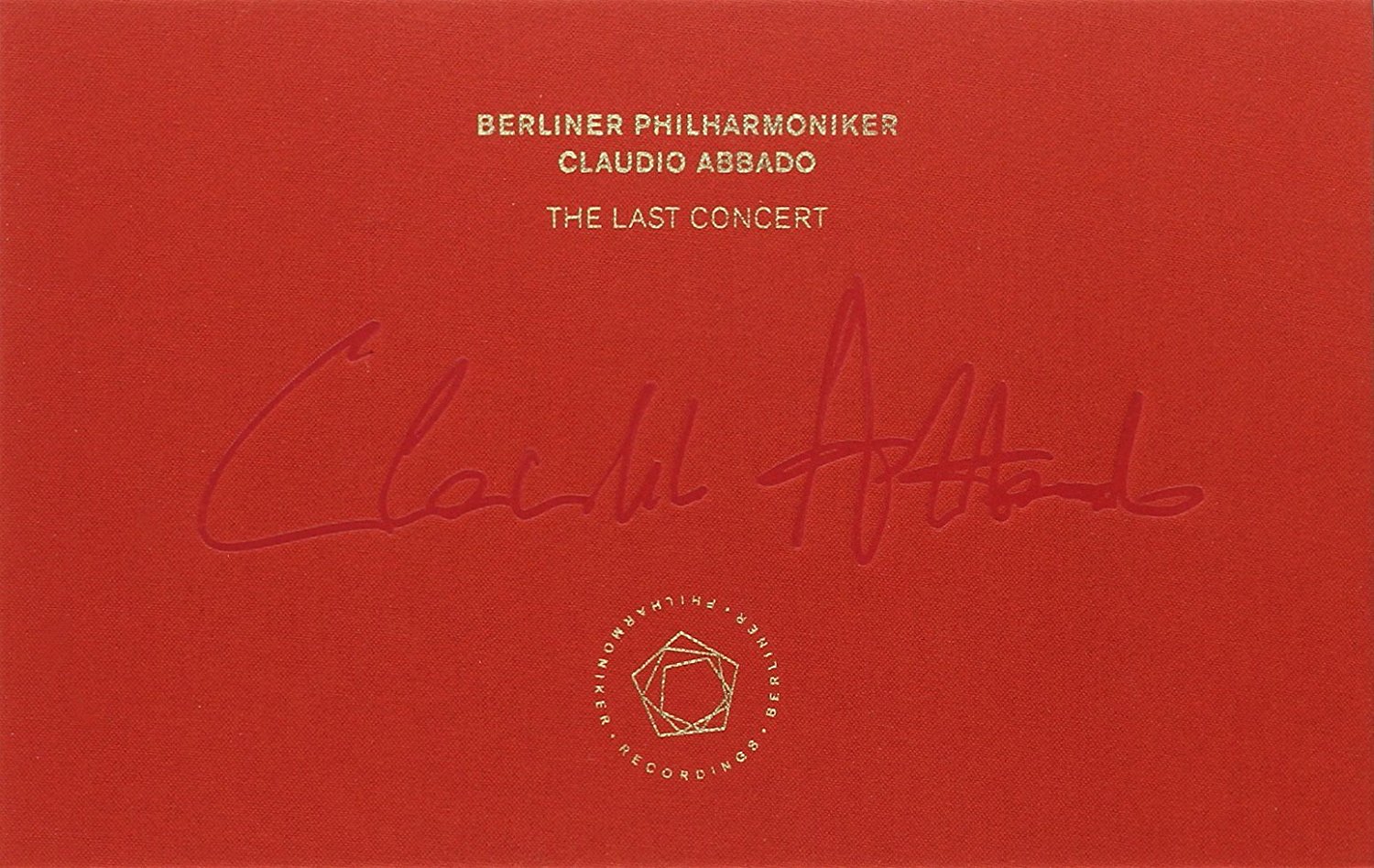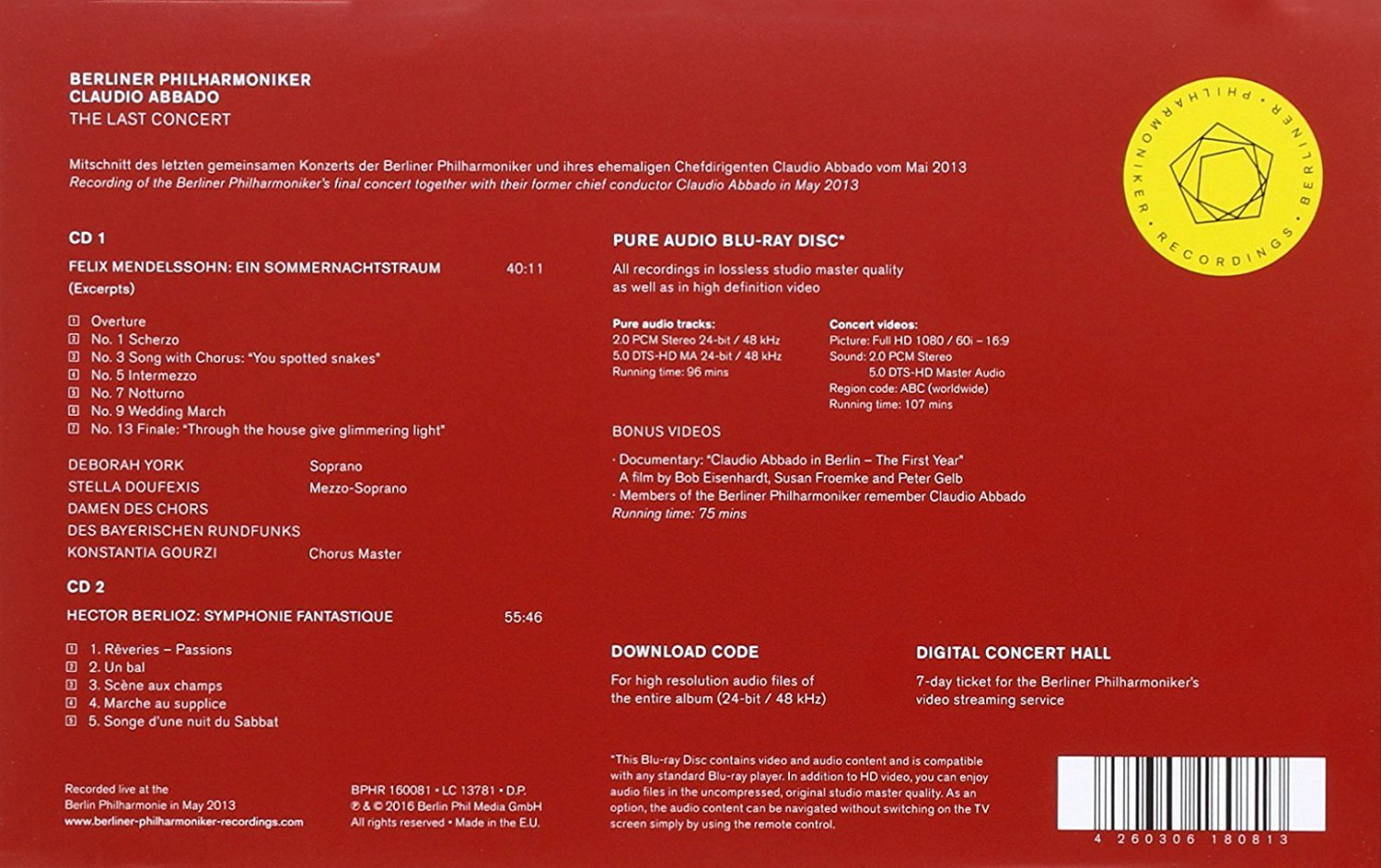

Claudio Abbado conducts the Berliner Philharmoniker for the last time. Recorded at the Berlin Philharmonie on 18, 19, and 21 May 2013. Two works are featured:
Mendelssohn: A Midsummer Night’s Dream (excerpts). Soloists are Deborah York (soprano), Stella Doufexis (mezzo-soprano). Chorus is comprised of women of the Chors des Bayerischen Rundfunks (Bavarian Radio Chorus).
Berlioz: Symphonie fantastique
Released 2016, the main feature for us is the Blu-ray video of the entire concert. The concert can also be played as a Blu-ray audio music recording. All Blu-ray music has 5.1 dts-HD Master Audio sound output (literature from publisher incorrectly states that sound is 5.0). In addition to the Blu-ray disc, there is a CD of A Midsummer Night’s Dream and a separate CD of the Symphonie fantastique. There is also a bonus documentary video. All this is included in an extravagant box set with a 56-page booklet of program notes and an article with numerous photographs honoring Claudio Abbado. Purchase of the box may include extras such as a 7-day ticket for the Berliner Philharmoniker’s video streaming service (“Digital Concert Hall”) and a download code for 48kHz/24 audio files of the performance (which the Berlin folks call "high resolution" files). Directed for TV by Daniel Finkernagal and Alexander Lück. No DVD version of this title is available. Could this be a sign that DVDs are aging out?
Grade: B- for the Mendelssohn and B for the Belioz
Abbado was the chief conductor of the Berliner Philhamoniker from 1990 to 2002. He was ill for a long time, but he continued working as long as he could. He died eight months after making this recording. (This was not Abbado's last recorded concert. Four months before his death, Abbabo made a last video recording with his Lucerne Festival Orchestra. You might also be interested in the Abbado Memorial Concert recorded by Andris Nelsons and the Lucerne Festival Orchestra a few months after Abbado died. )
Abbado was loved for his gracious and humble demeanor. He was also revered for his courage in working through the pain of his illness. At his final concerts, everyone attended rapt in awe, and they trailed in his wake as he led his own funeral cortège. The photo below is probably his last portrait with the Berliner Philharmoniker:
SQ & PQ
As you might expect for a recording by this famous orchestra in its home port, SQ is generally fine. But I'll mention several quirks just in case you are picky about such things. Playing the video, I hear some some odd, repetitive “pop” noises near the beginning of the last movement of Midsummer Night’s Dream and again at 41:46 (as the piece reaches its quiet conclusion). Each time the sounds last for about 15 seconds. I found these extraneous sounds to be more prominent in the 2.0 audio track than the 5.1, and they were much more present through headphones than through my speakers. On the plus side, I was not able to replicate the noises on the Blu-ray audio track, or in the high-resolution FLAC download audio files.
Picture resolution is also excellent throughout. There are a couple of instances in A Midsummer Night’s Dream where an image is taken from a camera while it is in the process of adjusting to the light in the hall (e.g. 36:21 / 36:22). The 2 images below are taken within a span of less than a second. When watching the video, this creates a noticeable visual “blip” (a flash of darkness relative to the images on either side):
A Midsummer Night's Dream
I grew up with many Abbado recordings, which might influence what “sounds right” to me. While I did not find anything particularly exciting in this performance, it was certainly enjoyable. At the opening, pizzicati dancing through the lower strings evokes the atmosphere of excited fairies fluttering through the night. Emmanuel Pahud’s flute solo at the end of the Scherzo is a highlight – very characterful and appropriately highlighted. The Notturno is taken at a relaxed yet flowing tempo. However, to my ears the first horn makes the music sound difficult – I longed for more legato and lushness of tone.
Even though this concert was not published in DVD form, old habits die hard. We must therefore be on the lookout for symptoms of DVDitis in the video content. I ran the numbers. There are 40 minutes, seven seconds of music divided into 290 video clips. This yields a pace of 8.3 seconds per clip.
Here is a breakdown of the video clips in this recording of A Midsummer Night’s Dream:
Conductor clips = 54
C/B clips = 13
Weak soloist clips = 3
*Realistic soloists clips = 9
Solos, small section, small group clips = 150
*Large section, large group clips = 42
*Part orchestra clips = 9
*Whole orchestra clips = 9 (but some while the orchestra was at rest)
Instrument only clips = 1
Other low value = 1 (anthill shot)
There are 69 "supershots" (add up the * numbers above of 42+9+9+9). So the supershots are 24% of the total clips. Conductor shots total 67 (54+13), and conductor shots claim 23% of the film (67/290).
HDVDarts.com has established the following rules-of-thumb to identify a Blu-ray with DVDitis:
A good symphony HDVD should have a slow pace with more than 10 seconds per video clip on average. 20 to 40% of the clips should be large-scale "supershots." Conductor shots should be less than 20% of the clips in the video.
Subject video flunks the pace test. It passes the supershot test, but only barely considering that some of the whole-instrument shots were of the orchestra at rest. The rule-of-thumb would say that there were too many conductor shots. But the rule-of-heart says that we cut some slack for the videographer in featuring Abbado in his last performance at the Philharmonie.
As to a grade, I reduce the A+ to A for lack of 96kHz/24 bit sound sampling. I reduce the grade to B for excessive pace. For weakness in supershots and the technical glitches noted I reduct the grade to it's final resting place of B-.
Now for some screenshots from A Midsummer Night’s Dream. I start below with a beautiful, clear whole-orchestra shot that also shows the soloists and choir:
A decent shot of the 1st violins:
This shot below of 2nd violins is hampered by a less-than-ideal camera angle:
The brass are more photogenic thanks to a better camera angle:
Shots of the lower strings are weak in this recording. I deemed the congested view below as "large-scale." Other wonks might call this a small-scale shot:
The congested view of the double basses below is not great, but you can see them all. I called it "small scale."
Things perk up with the choir shots:
It was not difficult to find a screen shot of the soloists smiling. Their performances matched the glow of their expressions. This shot counts as “realistic” as it is taken at a sufficient distance as to include their waists.
Everyone seemed pleased with the performance, including me!
Symphonie fantastique
I thought that the Berlioz opened strongly, with good contrasts in texture and dynamics. However, during the first 2 movements, I had a general impression that Abbado was not able to sustain linear momentum, phrasing interest, and orchestral clarity to the extent I was hoping for. Things picked up in the final 3 movements. Solo contributions during the Scene in the Fields are impeccable, with the perfect degree of nostalgia and individual inflection. I was charmed to see 4 timpanists creating the sound of distant thunder alongside the cor anglais at the conclusion of this movement. The March to the Scaffold appropriately provides snarl from the brass, a good bite from the lower strings, and an insistent tone from the bassoons. This concentration is carried successfully through to the end of the final movement, although this performance does not achieve the same level of intensity as I recall from Ozawa (on NHK) or Tilson Thomas (San Francisco Symphony’s Keeping Score series). The “vulgar dance tune” played by solo clarinet is perhaps the edgiest I have heard – depicting a truly insane and unbalanced character!
There are 56 minutes, 24 seconds of music divided into 360 video clips. This yields a pace of 9.4 seconds per clip.
Here is a breakdown of the video clips in this recording of Symphonie fantastique:
Conductor clips = 74
C/B clips = 7
Solos, small section, small group clips = 194
*Large section, large group clips = 56
*Part orchestra clips = 14
*Whole orchestra clips = 11 (but some while the orchestra was at rest)
Instrument only clips = 3
Other high value = 1 (architectural shot)
There are 81 "supershots" (add up the * numbers above of 56+14+11). So the supershots are 22.5% of the total clips (81/290). Conductor shots total 81 (74+7), so conductor shots claim 22.5% of the film (81/290).
HDVDarts.com has established the following rules-of-thumb to identify a Blu-ray with DVDitis:
A good symphony HDVD should have a slow pace with more than 10 seconds per video clip on average. 20 to 40% of the clips should be large-scale "supershots." Conductor shots should be less than 20% of the clips in the video.
Subject video flunks the pace test, but only barely. It passes the supershot test, but only barely considering that some of the whole-instrument shots were of the orchestra at rest. The rule-of-thumb would say that there were too many conductor shots. But the rule-of-heart says that we cut some slack for the videographer in featuring Abbado in his last performance at the Philharmonie.
As to a grade, I reduce the A+ to A for lack of 96kHz/24 bit sound sampling. I reduce the grade to B+ for mildly excessive pace. For weakness in supershots, I reduce the grade to B.
Now it's time for Berlioz screenshots. Isn't this a magnificent image of the expanded orchestra with 4 harps! But now there's little room left for TV cameras:
Too bad we didn’t get to see much of the harpists – there was no camera angle that showed their faces, except through the strings:
The harps interfered slightly with some otherwise decent large-scale shots:
The following 2 large-scale shots were marred by their duration – each lasting only 1 second. Literally a flash! Rest assured . . .these shots also appeared elsewhere in the production for longer durations:
There were a few different views of the double basses in this work . . .an improvement from the Mendelssohn title:
Here are a couple of images of Abbado at the close of the concert. In the first, he is trying to coax his musicians to stand up to accept the applause. Their refusal causes him to walk into the orchestra (2nd image) in a generous effort to share credit:
Wonk Bryan Balmer bought this item, reviewed the concert, made the screenshots, and wrote the text. Hank McFadyen helped with editing and a few ideas.
Here’s an official YouTube video:
OR
























